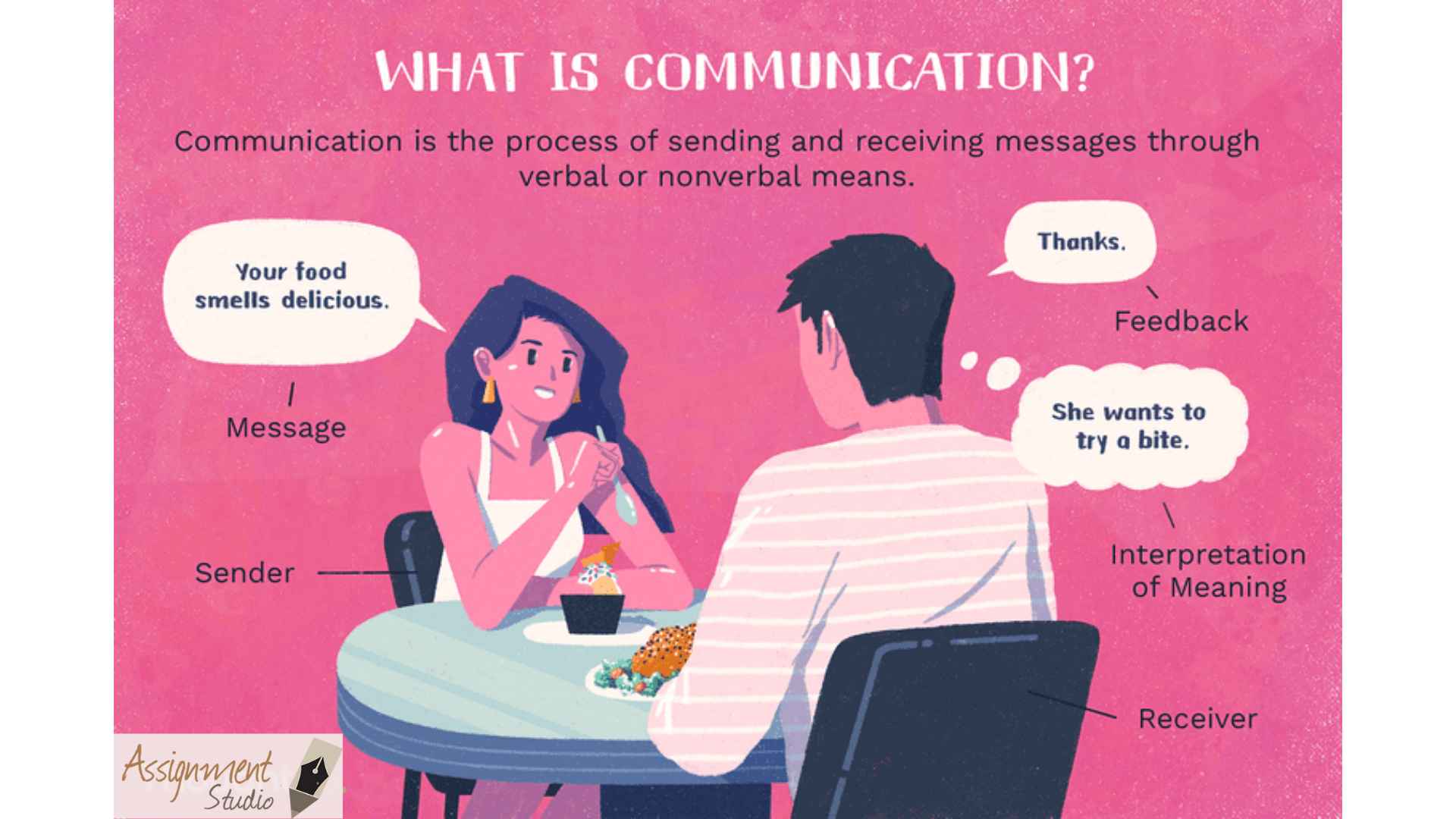Communication Assignment Help
Introduction:
It is an established fact that ‘Man is a social animal’ and the only fact that differentiates him from all other species is the capability to ‘think’. This initiates the processing of all information sensed and subsequently exploring the miracles of Mother Nature through his in-built inquisitive nature. When these humanly processes are categorized one of the major derivations is the skill to communicate. According to Schwartz (2001) the art of conveying a message to another individual which clearly depicts the intent, emotions, background and implications of the words chosen is called effective communication style.
Elevate your understanding of business law with Assignmentstudio. Our tailored services empower you to craft a Business Law Research Paper that reflects comprehensive research, critical insights, and scholarly rigor.
Description of the Context:
Communication is basically a skill on which so many diverse traits are hinged. As Richard (2008) has elaborated that effective communication acts like a bridge between people and the strength of this skill depends upon many factors. The selection of words, the correct expression, the emotional state, the underlying causes, the face expressions, hand and body gestures etc all greatly affect communication.
The art to communicate varies in huge magnitude depending upon the situation and more importantly the audience. Diverse communication skills come in handy once the subject changes. Any information if not conveyed in accordance with the mental capability, values and maturity level of the audience will not have the desired effect (Nielsen, 2008).
In the subject presentation also, once the audience and the background is analyzed, showing a well-educated and intellectual audience is present. In order to convince such an audience the argument and the presentation of the speaker must be of a very high quality. The location and the setup are eye-catching also so that it adds up to the overall impact. The speaker however fails to deliver his message in an appropriate manner if all these aspects are not properly in place.

Analysis:
When we analyze the performance of the speaker the two broad categories where his communication skills can be assessed are:
Verbal communication:
When the verbal communication of the speaker is analyzed one can see that:
Word Choice Structure:
One of the very important factors affecting good communication is the choice of words and the structure of speech. If the argument is well rehearsed and is delivered with confidence then the impact on the listeners is manifold. The correct expression is always the key to a convincing argument. (Davies, 2001)
Analysis:
- In the subject presentation it can be observed that the speech has not been rehearsed well therefore the speaker is giving an extempore argument. The fumbles and the pauses show that the necessary homework has not been done.
- Similarly the poor structure of sentences also indicates the lack of knowledge of the speaker about his topic. He is not fully conversant with the applications himself therefore it is depicted in his words as well.
- At one time when the speaker is not able to execute a desired application he exclaims in confusion and frustration which weakens his argument further. His actions lead to growing annoyance which subsequently lead to his exclamation. The reason again can be deduced as lack of knowledge about the product he is advertising.
Vocalics:
When we talk about the vocalics in communication it is important to note that it adds up to the impact of the speech. Richard (2008) maintains that if the flow of the words is correct and the required rhythm is built then it takes the audience in a trance and convinces them of the facts being told to them.
- Volume: The volume of the speaker is appropriate but the monotonous and constant note in his presentation does not attract audience. Varying the volume in terms of emphasizing on specific points would create more interest. The volume of a person while communicating often shows how confident he or she is about the subject. It has also been established by Schwartz (2001) that the volume is the best judge of the inner confidence but this can also not be generalized because the intrinsic speaking volume varies from individual to individual. With respect to this, some people who speak softly as compared to others must ensure that the volume is appropriate for the audience to make out the words and understand the speech. If some of the words are lost by the listeners then it is all the more reason for them to lose interest
- Rate: The rate and the speed of the speaker are understandable but at times he gets faster due to the building nervousness which makes it harder to comprehend. The words are understandable but the rate at which the speech is delivered must also be appropriate to keep the audience engaged in the session. If the rate is too fast or too slow then there is all the more chance that the audience will not be able to comprehend. The rate at which the words are delivered may be considered as directly proportional to the building nervousness of the speaker (Worth, 2004).
- Pitch: The pitch of the voice also plays a key role especially at the places where emphasis needs to be laid on a certain issue. Controlling the pitch is also necessary because too high pitched voice may cause irritation to the audience. Such annoyance may cause the listeners to lose interest in the speech and to wish for the continuous torture to end. Such results would obviously not be required to anyone. The speaker in the subject presentation although has a fine quality of pitch but again does not vary with the effects therefore it is not very impressive as far as audience is concerned.
- Cadence: The cadence or rhythm of a presentation or a speech matters a lot as far as building the interest of the audience is concerned. The rhythm and flow should be such as if the speaker has built an artificial world to which the audience have travelled. The pace should be such that the audience feels a part of them absorbed into the dynamics of the words. This trance if conjured can win the hearts of audience and leave them no choice but to fully agree with the point of view of the speaker. (Richard, 2008). The cadence here is not very correct due to nervousness the speaker could not get into the required flow during the presentation.
- Articulation: The articulation has a lot of affect on the speech as it acts as a bridge between facts. Ellis (2009) is of the view that the overall argument is bonded together through effective articulation. If the basics are not connected properly then a relevant link cannot be established within facts. If the missing link is not available then the audience cannot relate to the argument and subsequently lose interest.
In this presentation the articulation is not very impressive also due to unnecessary pauses and slight moments where the speaker fumbles and is at a loss of words.
Non Verbal Communication:
After the verbal communication part we come to analysis in the non verbal part of the presentation. The aspects are defined and discussed as follows:
Kinesics: The art of kinesics proves to be the most important tool in non verbal communication. It not only depicts the inner confidence of the speaker but also supports the argument with visual effects. Cundiff (2002) explains about kinesics that the most effective way to convey a message without using words is good, solid gestures. The movements not only catch the eye and create interest of the audience but also convince them about the facts.
Poyatos (2002) has also deliberated on the fact that kinesics include facial expression, body motions and hand gestures which add up to create an overall effect. These motions of hand and body express the emotional state of the speaker.
Motions and Depictions of Subject Presentation:
Different kinds of gestures depict different meanings like:
- Defensive postures of staying crossed armed or glancing sideways depict low confidence level. Similarly losing eye contact with the audience and fidgeting with the product show low confidence level.
- The speaker once when he could not show an application had to fetch a different product. Running towards the rostrum again depicts again lack of confidence and a nervous attitude.
- The speaker constantly waves his left hand at the audience which is not a very comforting gesture. It shows aggression in terms of unwilling had movements. This may be to cover up the lack of confidence.

Hire Expert Writers at
Affordable Price
WhatsApp
Get Assignment Help



